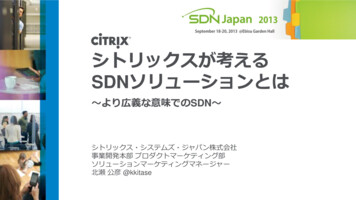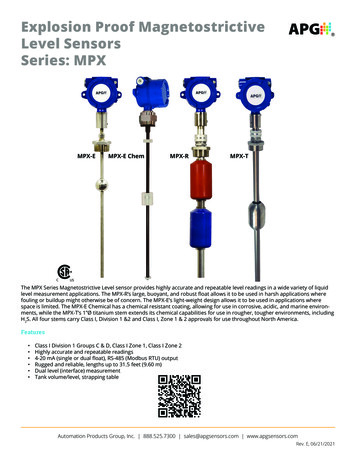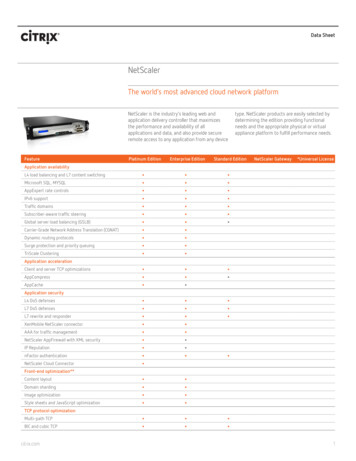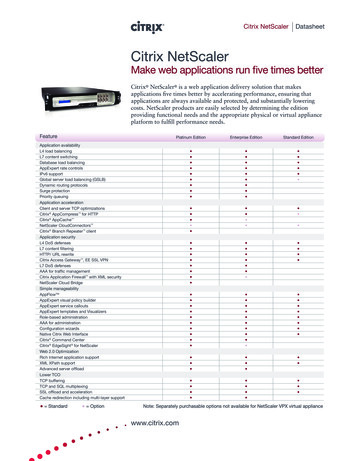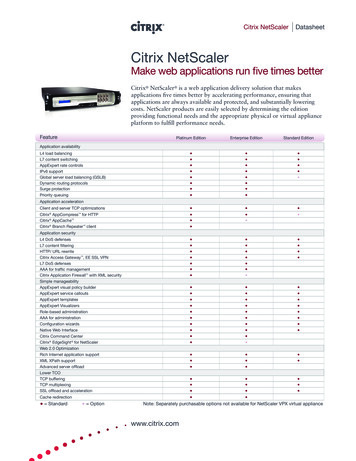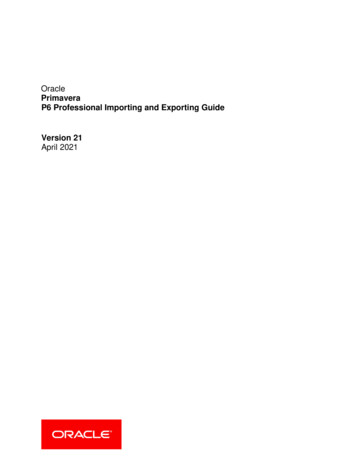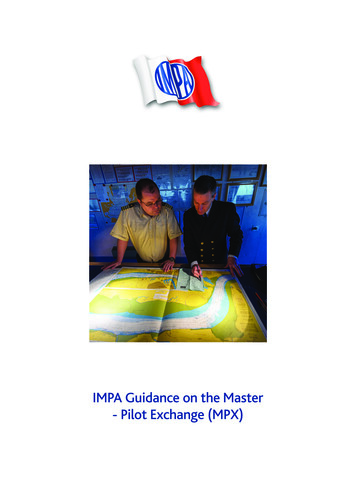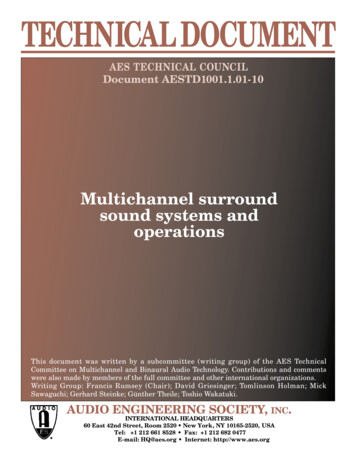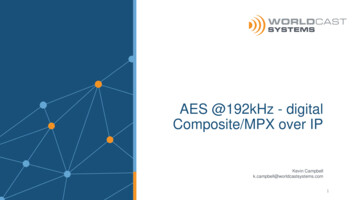
Transcription
AES @192kHz - digitalComposite/MPX over IPKevin Campbellk.campbell@worldcastsystems.com1
Digital Composite/MPX over AES over IPWHAT?WHY?HOW?2
WHAT?3
Composite/MPX over AES what is it about?The ContextIn an all-digital broadcast facility, an all-digital transmission path is desired.Mainly manufactures of sound processors are the driving force of the all-digital connection on atransmitter site.With the Composite/MPX over AES interface, a single AES-EBU cable between the sound processorand the transmitter carries the baseband signal in digital form. This 100% digital path eliminates thenoise and distortion of A/D converters and reduces potential overshoots, while ensuring full maskcompliance.It allows easy point-to-multipoint MPX connectivity on a single site utilizing the standard AES3distribution at 192kHz FS.4
Composite/MPX over AES what is it about?1) Digital Composite/MPX over AESDescribes the connection of a digital Composite/MPX signal over an AES link. This connection can bebetween a Sound Processor and digital Exciter, locally on a transmitter site.Linear PCM for digitalcomposite/MPX @ 192kHz FS3072 kbps (16bit)4608 kbps (24bit)5
Composite/MPX over AES over IP what is it about?2) Digital Composite/MPX over AESover IPDescribes the transmission of a digital Composite/MPX signal over an IP link or network and utilizeslocal “Digital Composite/MPX over AES” connections at the studio and the Tx site.The combination of both methods provide an all-digital transmission path throughout the FMnetwork.6
WHY?7
Composite/MPX over AES why?The ContextWe are seeing many audio processors being released with the AES @192kHz output capacity, likethe major players Wheatstone, Omnia and Orban – and there are many others.On the other side the FM transmitters increasingly are also being fitted with the new AES @192kHzformat.With the entire digital transmission path, courtesy of APT Codecs and others, that allows you tobreak the rules with the positioning of certain elements in the broadcast chain.It is no longer necessary to place the audio processor or RDS encoder at the transmitter site as wecan control influences on stereo separation and minimize overshoot behavior.In addition to the big reduction in legacy hardware by moving to the new AES @192kHz format youcan realize a major saving in new hardware.8
Composite/MPX over AES why?Customer ChallengeIP networks are the preferred distribution networks today. The advantages of flexible routing andcasting modes (unicast/multicast) are obvious. However, this also involves challenges that shouldnot be underestimated.There is the question of bandwidth optimization for network usage. How many stereo programs canI safely transmit as a composite/MPX signal? Are there optimization mechanisms?What happens to my composite/MPX signal if packet losses occur despite all protection of thetransmission? How does this affect the carrier deviation, and do I have to expect overshoots?Can I control the latencies of the IP transmissions?Which possibilities are there to transmit composite/MPX signals of the analog and the digital domain(hybrid) and still achieve hardware savings?.9
Composite/MPX over AES why?Our SolutionFor the composite/MPX signal a spectrum bandwidth of theoretically 100kHz is specified. In mostcontinents the range above the RDS signal is not used. For these cases, the APT composite/MPXcodecs offer a low pass function which limits the spectrum to 64kHz. This is not done at theexpense of quality (bit-depth reduction), but by reducing the sampling frequency.Packet losses can occur even if this is largely prevented by APT SureStream or similar mechanisms.When it happens, the effects on a second layer of protection must be rendered ineffective. APT hastherefore attached great importance to the Over Modulation Cancellation algorithm. This does notprevent packet loss, but overmodulation of the carrier.APT codecs have a low latency when transmitting the composite/MPX signal. In addition, theprogram's playback time can be controlled with the NTP time.Analog and digital composite/MPX signals or even normal stereo audio and RDS can be combined ina single codec frame, enabling hybrid transmissions. The encoder hardware remains modular andtherefore cannot influence each other.10
HOW?11
Composite/MPX over AES how?Good Reasons to look to APT for Composite/MPX over IP1) Bandwidth OptimizationUp to eight stereo programs can be transmitted as composite/MPX signals with a single 1u ModularCodec Frame. With APT's bandwidth optimization you can save over 8Mbps net bandwidth.12
Composite/MPX over AES how?Bandwidth OptimizationFS 128kHz allows MPX bandwidth limitation to Audio and RDS – band limit at 64kHz.Saves network capacity: @16Bit 2048 kbps (net 3072kbps for full bandwidth).13
Composite/MPX over AES how?2) Overmodulation CancellationA unique feature of APT composite/MPX Codecs is their ability to cancel out undesired peaks andtroughs of the composite/MPX signal to reliably prevent overmodulation, caused by dropped IPpackets.APT MPX codecs deploy a 'watchdog' service which ensures that, should there be any distortion orcorruption of the signal due to packet losses, it will not lead to overmodulation.14
Composite/MPX over AES how?3) Low Latency and latency ControlAPT codecs also have low latency for composite signals. In addition, the target delay can bedetermined by the NPT time.15
Composite/MPX over AES how?4) Simultaneous Analog and digital Domain SignalsSimultaneous analog & digital composite/MPX and baseband audio program over IPThree possible scenarios:16
Composite/MPX over AES how?5) Digital to Analog composite/MPX transmission with 1U Codec FrameThe mix of digital and analog composite/MPX transmission allows seamless migration from centralanalog signal processing to digital processing regardless of the transmitter generation in use.17
Digital Composite/MPX over AES over IPNew Zealand -Case Study18
New Zealand – Why, Composite AES 192Long Linear country with many high sitesGeographical characteristic of the country mean highest power FM Transmitter is5KWMany sites are inaccessible for many months except by helicopterMost links to the site are microwave (LOS), many are provided by Kordia (nationalTelco)Kordia tariff these links per MBSingle FM content is required to be delivered to multiple sites, Main FMTransmitter and repeater / gap filler FM TransmittersMany co-located stations with multiple frequencies and multiple transmitter sitesEnd destination is the full digital chain BUT many aging analogue transmitters stillto be replaced19
New Zealand – AES 192 ChecklistScenario (Problem)BenefitSavingsInaccessible SitesRemove equipment from thetransmitter site (Processors,RDS Encoders etc.)-Site visits (by helicopter)Kordia Tariffed MicrowaveLinks at 2MBits-bandwidth optimization(3072kBits - 2048kBits) fitsin 2MBit pricing-Kordia Telco Costs notincreased in migrationSingle FM Frequency toMultiple sitesUnicast and Multiple-unicastover IP-Reduce dramatically the audioprocessing hardwareMultiple FM signalscollocated at a singlestudio-APT 1U Frame provides thehighest density MPXComposite on the market-Reduce the audio codechardwareAnalog MPX gear-APT can provide Analog andAES MPX – Composite over IP(Hybrid)-Maintain legacy gear along sidenewer transmitters andprocessors20
New Zealand – AES192Ottaga Site - 1,500Meters up21
New Zealand – AES192Ottaga Site – APT MPX-Composite IPCodec Ecreso 1KW FM Transmitter22
Key TakeawaysComposite/MPX overAES @192kHz23
Composite/MPX over AES summaryAES @192kHz: The drivers are varied but can be summarized as: Density of signals means you can reduce drastically the amount of hardware making up theSTL portion of your broadcast chain;IP topologies including unicast and multicast mean you can do more with less; one encodercan hit multiple composite/MPX decoders;Cost reduction in new hardware related to audio processing and traditional discrete STL; onetop-end audio processor can now serve multiple sites and still employ the essential compositeprocessing elements such as clippers etc., not to mention those with built-in RDS;Flexibility – hybrid technologies mixing analog composite with AES @192kHz composite/MPXare easily achievable.Studio positioning of audio processors means easy access for servicing and adjustments, postprocessing in-ear monitoring for talent is achievable in an IP environment.24
Your Questions!THANK YOU!Kevin Campbellk.campbell@worldcastsystems.comKcampbell apt 44 7545 921603 / 1 305 809 0374www.worldcastsystems.comSpecial thanks to Marcus Bekker, Southern Broadcast New Zealand25
With the Composite/MPX over AES interface, a single AES-EBU cable between the sound processor and the transmitter carries the baseband signal in digital form. This 100% digital path eliminates the noise and distortion of A/D converters and reduces potential overshoots, while ensuring full mask
